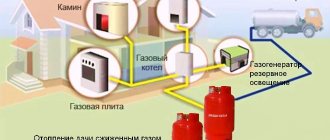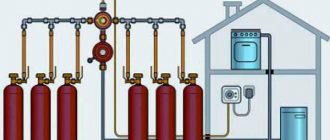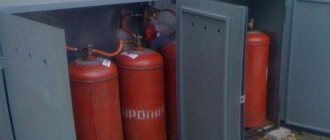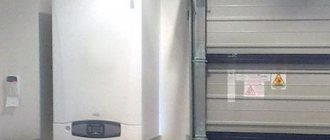To install a heating system, you will need a source of thermal energy. This can be main or liquefied gas, firewood, electricity or liquid fuel. The most profitable option is gas. But not all settlements have mains gas. In this case, use its liquefied version. If you decide to use a gas cylinder for heating, you need to familiarize yourself in advance with the advantages and disadvantages of such systems, as well as understand the nuances of their design.
Bottled gas heating and what is it?
Heating systems that use liquefied gas to heat the coolant are the type we are describing. If methane gas circulates in the central line, then the cylinders are filled with propane or a mixture of butane and propane. Heating with gas cylinders in a private house is done if it is not possible to connect to a centralized gas supply.
Such systems are used in houses with an area of 70-100 square meters. In this case, the building must be well insulated to minimize fuel consumption. Also, to save gas, it is recommended to use not only a boiler running on this fuel, but also electrical heating appliances.
Important! The fuel is in cylinders under high pressure, so disassembling or damaging the containers is prohibited.
Pros and cons of balloon heating
Gas heating from bottled gas has the following advantages:
- The cylinders contain fully purified fuel, which promotes complete combustion in the boiler chamber. As a result, no slag or ash remains.
- Gas-fired heating equipment does not need to be connected to power supply systems, so such heating can be called energy-independent.
- The heating system works stably and smoothly, and its operation is easy to manage.
- Ease of operation is an additional advantage of bottled gas heating.
- The price of gas is the lowest in comparison with other types of fuel.
- The efficiency of such a system is quite high and reaches 90-95%.
- If necessary, heating equipment can be converted to operate on mains gas.
- An impressive service life can also be considered one of the advantages of such heating.
Used cylinders can be sold on the secondary market to offset some of the costs. If you install a double-circuit boiler running on liquefied gas, you can not only heat the house, but also provide it with hot water supply.
The disadvantages of heating with propane or a mixture of propane and butane are the need to regularly refill gas storage tanks. In addition, for the correct and uninterrupted operation of the system, certain conditions must be created.
Selecting a gas tank: types of equipment
Gas tanks can be divided into several types depending on how and where they are installed. So, the equipment can be both underground and aboveground , and the first option is much more popular than the second, since it will not interfere with the site and freeze. The underground tank is installed underground so that the layer of soil above it is at least 60 cm. Otherwise, there is a risk of freezing of the equipment or the possibility of causing mechanical damage to the cylinder. You can easily install a tank with a volume of 1.5-10 thousand liters underground, which will not even be noticeable. Only the neck remains on the surface, and this is the main advantage of such models.
Underground gas tank
Aboveground gas tanks can also be large, but they will definitely spoil the appearance of the site, and therefore are usually small. However, in some cases the installation of such equipment is justified - for example, when for some reason the tank cannot be installed underground, but you want to have an autonomous gas supply system. An above-ground tank must be able to withstand high temperatures because it may be exposed to direct sunlight. But it is still recommended to keep the equipment out of harm’s way.
On a note! If you plan to install an above-ground gas tank, but large volumes of gas are needed, then the easiest way is to install several cylinders of modest size and connect them together into a single system.
Aboveground gas tank
Gas tanks are not only stationary, but also mobile. True, their volumes are small (only 500-700 liters). But such a tank can be transported by a regular car and even taken to a gas station yourself. Usually used in dachas or where people live temporarily. Gas holders can also be vertical or horizontal.
Table. Types of gas tanks by design.
| Type of equipment | Description |
| Vertical | This type of model allows you to save space on the site. But the pit for such equipment will have to be dug very deep (it is important to remember that there may be groundwater underground). But the gas in such containers, due to their large depth, is well cooled in the summer, and, on the contrary, does not freeze in the winter. It is important to remember that for normal gas supply, its temperature must be above zero. |
| Horizontal | Such tanks take up more space, but are easier to install, since you don’t have to dig a deep pit for them. Not the best option for a modest-sized area, although a lot depends directly on the volume of the tank itself. |
Scheme of using a gas holder
You can also divide gas tanks into two types depending on the type of neck:
- high neck (Russian standard);
- without neck (euro).
Equipment without a neck is cheaper, but abandoning it is not always justified. The presence of a neck will allow you to install the platform with the reinforcement as high as possible, which will protect it from moisture. If water gets into the reducer, the gas supply will be stopped. There are also gas tanks without a neck, but their fittings are located on high tubes, and you don’t have to worry about water getting into them.
Cylindrical gas tanks
Connection diagram for gas cylinders to a heating boiler
To connect the cylinder to the boiler, a special reducer is used, which converts liquefied fuel into a gaseous state. It is in this form that it is supplied to the heating equipment. If several containers are used at once, then the same number of reducers will be needed to connect to each cylinder. This is much safer than connecting several containers at once through one common gearbox.
Important! If you use several cylinders, you can increase the operating interval of the equipment on one fuel fill.
To assemble the entire structure, a two-arm collector is used. This is a special ramp that divides all containers into two groups. One group is the main one. From it, gas enters the boiler first. The second group is the reserve group. It is used after the main group runs out of gas. Switching from one group to another occurs automatically. At the same time, a characteristic signal is heard. After refueling and connecting the tanks of the main group, the collector begins to consume fuel from these cylinders.
Gas equipment for home heating - burners for stoves and boilers
All containers with fuel are installed from the boiler at a distance of no closer than 200 cm. It is best to allocate a separate room for these purposes or fence off a compartment in the furnace room. It is prohibited to install cylinders in an uncovered place exposed to sunlight.
To connect containers, metal pipelines with a wall thickness of less than 2 mm are used. In the place where the pipes pass through the walls, protective cases are installed, and all openings are filled with foam. A durite hose is used to connect the pipeline to the heater.
The best wall-mounted gas boilers
This section presents single-circuit room heating systems placed on the wall. They are compact and easy to maintain, although they have some limitations in functionality.
Viessmann Vitopend 100-W A1HB003
4.9
★★★★★ editorial assessment
89% of buyers recommend this product
The A1HB line includes three boilers with a capacity of 24, 30 and 34 kW. This is enough to heat a home with an area of up to 250 m2. All cases are equally compact: 725x400x340 mm - such units have a place in any room.
Viessmann boilers are assembled on a single modular platform, which simplifies their installation and maintenance. In addition, there is no need to leave additional space near the body, so any Vitopend can be combined with kitchen furniture if there is a free corner for it.
Advantages:
- Low gas consumption - no more than 3.5 m3/h in the older model;
- The valve body is equipped with quick-release connectors;
- Automatic power adjustment depending on the outside temperature;
- Efficiency up to 93%;
- New coaxial chimney system with frost protection;
- Intelligent control with self-diagnosis function;
- Possibility of switching to liquefied gas.
Flaws:
There is no remote control panel.
Viessmann provides the opportunity to choose a boiler for an apartment of any size. The appearance and dimensions for the entire line are absolutely the same - the models differ only in performance and, accordingly, gas consumption.
Baxi Eco Four 1.24 F
4.8
★★★★★ editorial assessment
88% of buyers recommend this product
See review
Despite the prestige of the brand, the Eco Four model is relatively inexpensive. The boiler has a flat body measuring 730x400x299 mm, which allows it to be hung flush with kitchen cabinets. When used in northern latitudes, such a unit can heat an apartment up to 150 m².
Fourth generation boilers were developed taking into account our operating conditions. That is why the presented model operates even when the inlet gas pressure is reduced to 5 mBar. In addition, it has two separate thermostats: for heating radiators and for the “warm floor” system.
Advantages:
- Built-in water flow meter;
- Pump with air vent and post-circulation mode;
- It is possible to connect to solar collectors;
- Dual-mode thermal control;
- Pressure switch for protection against low coolant pressure;
- You can connect a remote thermostat and remote control.
Flaws:
Low-informative built-in display.
As for Baxi, Eco Four's price is very attractive. In addition, this is an excellent solution for placement in a small kitchen or studio apartment.
Vaillant AtmoTEC Plus VU 240/5-5
4.7
★★★★★ editorial assessment
87% of buyers recommend this product
This boiler has all possible means of protection: gas control, pressure switch with safety valve, pump air vent. Here, overheating of the medium and combustion chamber, freezing of liquid in the system and in the chimney are completely excluded. The built-in auto-diagnostics helps monitor the correct operation of all systems.
AtmoTEC is adapted for operation in Russia: it takes into account the low quality of main gas and can operate on LNG. The programmer control is fully automated, and the panel itself is covered with a neat decorative cover.
Advantages:
- Volumetric expansion tank 10 l;
- Low gas consumption – 2.8 m³/h (or 1.9 m³/h when connected to a cylinder);
- Almost eternal chrome-nickel burner;
- Possibility of combination with other heaters;
- The minimum side clearance during installation is 1 cm.
Flaws:
Classic (atmospheric) chimney.
The boiler dimensions of 800x440x338 mm and a maximum power of 36 kW are more suitable for a private home than for a city apartment. Although in a spacious kitchen there will be no problems with its placement.
Components for cylinder heating systems
Heating using liquefied gas is done using the following components:
- heating equipment with a gas burner;
- reducers for connecting cylinders;
- fuel containers with a capacity of 50 liters;
- ramp;
- rubber-fabric sleeve for connecting the pipeline to the boiler;
- shut-off valves.
The connection diagram is very simple, so it can be implemented by hand. When choosing a suitable gas boiler, give preference to units operating at minimum pressure and maximum efficiency. Consider what type of fuel the boiler is designed for. There are units that run only on liquefied gas. But if in the future you plan to connect the main gas supply, then it is better to prefer universal models that can operate on different types of fuel.
The gas boiler burner must have narrow nozzles that are designed to operate under high pressure bottled gas conditions. Units designed to use mains gas have wide nozzles. If liquefied fuel is supplied through such devices, an accident may occur.
Boilers designed to operate on LPG (liquefied petroleum gas) have special nozzles and a gas valve. To independently convert a conventional boiler to operate using liquefied fuel, you will need to purchase the necessary parts.
How to calculate gas consumption?
To calculate fuel consumption, you need to know the power of the heating equipment. When determining it, they use the rule that for every 10 square meters of heated area, a boiler power of 1 kW is required.
Autonomous heating system for a private house with a gas boiler
Thus, to heat a house with an area of 100 square meters, you need a boiler with a power of 10 kW. To generate 1 kW of thermal energy, approximately 0.12 cubic meters of gas per hour are consumed. To heat such a house for one hour you will need 1.2 m³ of fuel. Knowing this number, it is easy to calculate the daily fuel consumption. It will be 28.8 cubic meters.
At first glance, it seems that gas consumption is quite high. But these values are valid only for continuous operation of the boiler during the first warm-up of the system immediately after its startup. In the future, the equipment will operate in automatic mode and fuel consumption will decrease.
As a rule, to maintain the temperature in a house with an area of 100 square meters within 22°C at sub-zero temperatures outside, you will need about three cylinders of fuel per week. If at night the temperature is maintained 4-6 degrees below daytime, then fuel consumption will be reduced by a whole cylinder.
If the containers are used to heat a summer cottage for seasonal residence, then the operation of the boiler can be adjusted so that during the absence of the owners in the building the temperature is maintained within +5°C. This will ensure economical fuel consumption. As a result, to heat a small house for 7-10 days you will need only one cylinder of liquefied fuel.
Select the volume and calculate the costs
To choose the right gas tank, it is important to decide what volume it should be. This figure can be calculated taking into account gas consumption per 1 m2 of living space. In warm regions, consumption per 1 m2 averages 25-30 m3, and where it is cold - at least 35 m3. The need for gas can be calculated as accurately as possible by focusing on the power of the heating boiler - about 100 liters of fuel are consumed per 1 kW per year. You can also calculate the volume of the container in another way: if cylinders were used, then you need to estimate how many of them were spent per month and multiply the resulting number by 12.
How to position the gas tank correctly
Important! It is worth understanding that the cylinder is not 100% filled with gas. Approximately 15% of the volume must be free to allow gas to expand when heated.
The market for such equipment offers tanks of various volumes - from 2 to 10 thousand liters. It is important to choose a container that will need to be refilled no more than twice a year. For example, for a building with an area of 100 m2, a gas holder with a capacity of 2700 liters is sufficient . A tank with a volume of 10 thousand liters is suitable for a house of 300 m2.
Table of the ratio of the heated area and the optimal volume of the gas holder
The cost of gas is low, but it is important to understand that when refueling equipment you will have to immediately pay for a large volume. So, in the spring, gas costs less (about 15 rubles per liter), in the winter it gets a little more expensive - up to 20 rubles, because the demand for it grows at this time of year. That is, to refill a 4800 liter gas tank you will have to spend at least 58,000 rubles. in spring, and in winter - all 80,000 rubles.
Advice! If possible, it is better to choose a gas tank in such a way that you do not need to fill it often and fill it during the period when gas is the cheapest.
How else can you choose the volume of a gas tank?
The operating temperature range for the equipment is -40 – +40 degrees. But for a reservoir that will be located underground, these data are not critical - such indicators are not found in the ground. But if the system is installed incorrectly in winter, the gas supply may stop (this is due to freezing of the communications supplying gas to the house).
Prices for gearboxes for gas tanks
Reducer for gas tank
Safety precautions when using gas cylinders
If liquefied gas is used to heat your home, you must adhere to the following safety requirements:
- When the system freezes, it is prohibited to use open flames to heat the cylinders. In case of any fire within the house, fuel containers must be removed as far as possible from the fire.
- If a separate room cannot be allocated for fuel containers, then it is impossible to install the cylinders near the cellar or basement, because the gas can fall down. If it gets into the basement, it can lead to an explosive situation or poisoning of people who go down into the room.
- When connecting containers, a leak meter must be installed to minimize the likelihood of explosion and fire.
- It is prohibited to store empty cylinders in the house. For these purposes, a separate building must be allocated, located no closer than 10 meters from the house.
Attention! To ensure safety, the system is inspected and preventive maintenance performed every 4 years.
Reviews about heating features
Perhaps the most important inconvenience is that the owner will have to control the gas level, replenishing it in time. For some, it is considered an advantage when you can enjoy the benefits of complete autonomy and independence from the central gas supply. For other consumers this is a disadvantage. However, if you responsibly control the level of fuel supplies, interruptions and problems with heating will not arise.
If you want to arrange heating with liquefied gas, you must remember that a 50-liter cylinder is filled with fuel and can be used for small cottages, dachas and houses. Every few days you will have to replace the empty cylinder with a new one, which can be inconvenient, so experts advise connecting several cylinders by looping them. Consumers emphasize that when installing a heating system with liquefied gas, it is allowed to form a battery of three cylinders. If you want to combine a larger number of them, you should prepare a project and relevant documents.
The cylinders cannot be installed inside the house; they can be placed outside, where they will be located in a metal cabinet. In frosty weather, condensation may form or the gearbox may freeze. This will make it difficult to supply gas. To avoid such inconveniences, consumers are advised to install an electric heater in the closet. Such a system can be convenient if the area of the house is not very large and there is confidence that there will be no problems with the delivery of raw materials. When this moment is in question, it is better to purchase a gas tank.
It is a bunker for refilling liquefied gas and storing it. Such a tank is filled 1 or 2 times every three years. The reservoir may have different volumes. You can choose it according to your needs. This parameter varies from 3 to 10 cubic meters. The gas holder can be placed at a distance of 10 m from the home. If you plan to heat a private house with liquefied gas from a gas tank, you will need to provide a convenient access road to it.
The nuances of using cylinders in winter
If bottled gas is used to heat a country house, then in winter you need to take care to protect the fuel from freezing.
This is especially true for buildings for seasonal use, for example, dachas, when the owners come to the house only on weekends. If fuel containers are stored outside the house, then at sub-zero temperatures the pressure in them decreases. If the pressure drops significantly, heating equipment may stop working. To avoid this situation, containers with fuel during cold weather are installed in a special cabinet with a built-in ventilation system. Non-flammable insulation is used to insulate the cabinet.
If there is no such cabinet, then it is better to store containers with fuel in an extension to the house, in which there is no heating, but a positive temperature is constantly maintained due to good insulation. Do not forget about other safety requirements when choosing a suitable place to install cylinders for the winter.
Gas tank installation
The installation of a gas tank itself is not difficult; its connection itself will cause more complications. That is why it is important to entrust the work to professionals. But in general, you can try to understand the system on your own. However, you can definitely do the installation of the tank yourself.
Step 1. First of all, you need to dig a pit suitable for the size of the gas holder. Before installing the gas pipeline, it is important to lay a warning tape that has an indelible inscription indicating the presence of gas.
First you need to dig a pit
Step 2. Next, you need to arrange a gravel bed by pouring gravel onto the bottom of the pit. It is also important to take care of creating a concrete base - it can be poured, or you can simply lay a concrete slab on the bottom of the pit.
Preparing the pit bottom
Laying a concrete slab
Step 3. After this, it is enough to lower the gas tank itself to the bottom of the pit and be sure to secure it with metal pins and cables.
The gas tank itself is lowered
It is important to secure the tank well
Step 4. Next you need to make a trench from the gas tank to the house. Pipes will be laid in it to supply fuel to the residential building.
Digging a trench
Step 5. You need to lay a gas pipe in the trench and bring it to the house.
Pipe laying
Prices for multilayer pipes for gas
Multilayer gas pipe
Step 6. One of the important stages is the installation of the gas supply system. Here it is better not to act on your own, but to call a specialist.
It is better to entrust the installation of the gas supply system to a specialist
Gas supply system being installed
Step 7. After installing all elements of the system, you need the technician to check its tightness using a special solution.
Checking the tightness of connections
Step 8. Then you need to connect all the devices and test the system for functionality.
System testing
Step 9. Only after this can the pit with the gas holder be filled with soil. It is recommended to fill it with sand.
A pit with a gas holder is filled in











